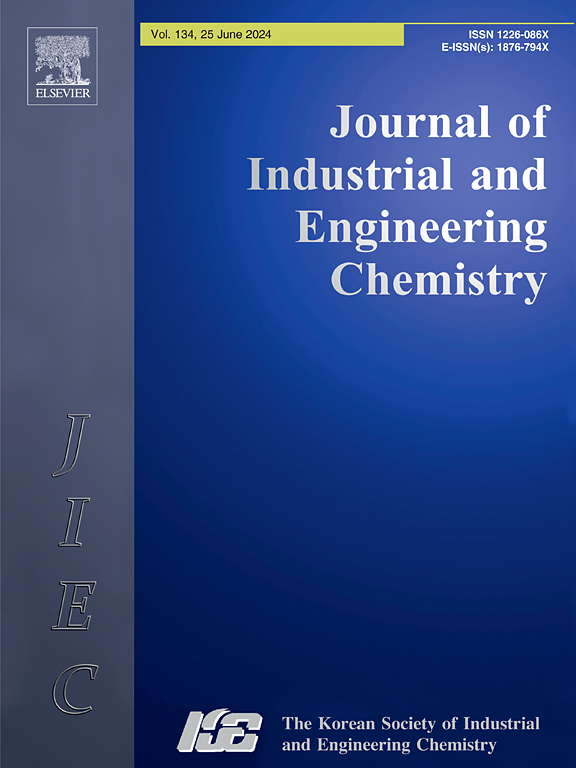Zn-doped aerogel for Ni2+ adsorption (Zn-A-Ni) and reuse of Zn-A-Ni to create Zn, Ni-co-doped carbon aerogel for applications in adsorption and energy storage
IF 5.9
3区 工程技术
Q1 CHEMISTRY, MULTIDISCIPLINARY
Journal of Industrial and Engineering Chemistry
Pub Date : 2025-01-25
DOI:10.1016/j.jiec.2024.07.010
引用次数: 0
Abstract
In order to solve the problem of heavy metal pollution, in this study, Zn-doped aerogel (Zn-A) was used as a material to remove Ni2+ from wastewater. Zn-A was synthesized from sodium alginate and nipa palm shell-derived cellulose via the sol–gel method combined with freeze-drying. Zn-A has the ability to adsorb Ni2+ up to 194.2 mg/g (Zn-A-Ni). After adsorbing Ni2+, Zn-A-Ni was pyrolyzed to form Zn, Ni-co-doped carbon aerogel (Zn-CA-Ni), which has high potential for manufacturing electrodes in supercapacitors (specific capacitance reaches 124.0F/g) and crystal violet treatment (adsorption capacity reaches 38.7 mg/g). Furthermore, Zn-A and Zn-CA-Ni were characterized through modern methods: Scanning electron microscope, energy dispersive X-ray, Fourier-transform infrared spectroscopy, X-ray diffraction analysis, and Nitrogen adsorption–desorption isotherm. The ability to adsorb Ni2+ of Zn-A and adsorb crystal violet of Zn-CA-Ni was determined through ultraviolet–visible spectroscopy measurement. In addition, the electrochemical properties of Zn-CA-Ni were also analyzed through cyclic voltammetry, galvanostatic charge–discharge, and electrochemical impedance spectroscopy.

用于吸附 Ni2+ 的掺锌气凝胶(Zn-A-Ni),以及重复利用 Zn-A-Ni 制造掺锌、掺镍碳气凝胶,用于吸附和储能应用
为了解决重金属污染问题,本研究采用掺杂锌气凝胶(Zn-A)作为材料去除废水中的Ni2+。以海藻酸钠和棕榈壳纤维素为原料,采用溶胶-凝胶法结合冷冻干燥法制备锌- a。Zn-A对Ni2+的吸附能力高达194.2 mg/g (Zn-A- ni)。吸附Ni2+后,Zn- a - ni经热解生成Zn、ni共掺杂碳气凝胶(Zn- ca - ni),具有很高的制备超级电容器电极(比电容达到124.0F/g)和结晶紫处理(吸附容量达到38.7 mg/g)的潜力。采用扫描电镜、能量色散x射线、傅里叶变换红外光谱、x射线衍射分析和氮吸附-脱附等温线等现代方法对Zn-A和Zn-CA-Ni进行了表征。采用紫外可见光谱法测定了Zn-A对Ni2+的吸附能力和Zn-CA-Ni对结晶紫的吸附能力。此外,还通过循环伏安法、恒流充放电法和电化学阻抗法分析了Zn-CA-Ni的电化学性能。
本文章由计算机程序翻译,如有差异,请以英文原文为准。
求助全文
约1分钟内获得全文
求助全文
来源期刊
CiteScore
10.40
自引率
6.60%
发文量
639
审稿时长
29 days
期刊介绍:
Journal of Industrial and Engineering Chemistry is published monthly in English by the Korean Society of Industrial and Engineering Chemistry. JIEC brings together multidisciplinary interests in one journal and is to disseminate information on all aspects of research and development in industrial and engineering chemistry. Contributions in the form of research articles, short communications, notes and reviews are considered for publication. The editors welcome original contributions that have not been and are not to be published elsewhere. Instruction to authors and a manuscript submissions form are printed at the end of each issue. Bulk reprints of individual articles can be ordered. This publication is partially supported by Korea Research Foundation and the Korean Federation of Science and Technology Societies.

 求助内容:
求助内容: 应助结果提醒方式:
应助结果提醒方式:


